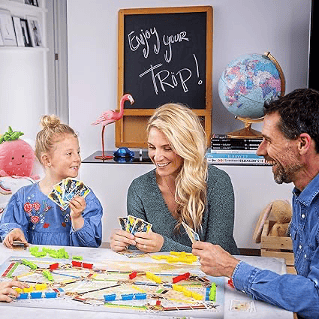
This is part of our series on board games by age. For more info check out our comprehensive guide to choosing board games for kids.
How to Pick the Right Board Game for a 6 Year Old
At around six years old, children are starting to learn more about the world and understand more about how it works. They are still only young and have a long ways to go! That said, if you’re a board game fan, you’ll probably find that from about six years old, options start to open up significantly more for kids at this age. They become marginally more complex and cerebral and start to put a little more emphasis on strategy, logic, communication and critical thinking.
A perfect board game for children at this age shouldn’t run for too long. Up to about thirty minutes is just about right. There are more games that add a competitive element at this age but there are still plenty of cooperative ones too. Rules are still fairly simple for most games aimed at six-year-olds, but they do start to branch out into slightly more complex rulesets, though there are normally options that will also make things more simple. Additionally, certain games can help develop fine motor skills through activities like selecting pieces from a bag or stacking elements. Engaging in such games not only enhances fine motor abilities but also promotes other developmental areas such as decision-making and strategic thinking.
Below is a mix of the best board games kids can start to play from six years old that we think would be great for your little one. Not only that, but some can serve as gateway games for more complex ones a few years down the line.
What Are the Best Board Games for 6 Year olds?
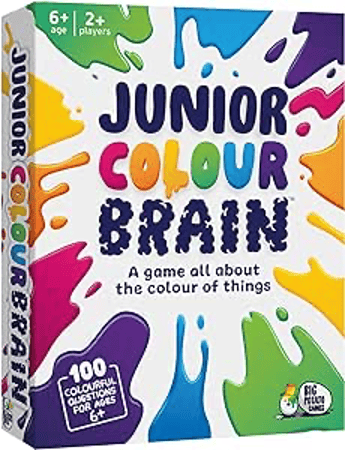
Color Brain
By: Big Potato Games Players: 2-20 Time: 10-20 minutes
Do you know what color Neptune is? How about a box of Coco Pops? And what about the three turtle shells in Mario Kart? If so, you could play a pivotal role in helping your team win at Color Brain!
Color Brain gives players the answers to each question from the start. They just have to use the right one! Players will be given eleven cards at the beginning of the game, each one representing a different color. Question cards are then shuffled and placed with the question facing up.
When a question card is played, players will then need to use their cards to guess which color, or colors, the object or thing in the question is related to. For example, if the question asked “What are the three colors of a traffic light?” the correct answer would be red, yellow, and green. Players will then lay the colors they think are correct face down to make their guess.
Once everyone has made their guess, the answer is revealed, along with each player’s guess. Scoring is based on how many players guessed correctly and only if a player guesses right and at least one other player guesses wrong, they score a point. If all players correctly guess, nobody scores, but in the next round the players who guess correctly will receive a bonus point. If nobody guesses correctly then nobody gets any points.
The first to ten is the winner. With over 300 question cards, learning the game should keep kids busy as they’ll rarely come across the same questions twice.
Color Brain is simple, fun and addictive! The questions are specifically catered to kids but the whole family will find the game enjoyable yet challenging. It makes for a great party game to play at home or take with you on the go!
We earn a commission if you make a
purchase, at no additional cost to you.
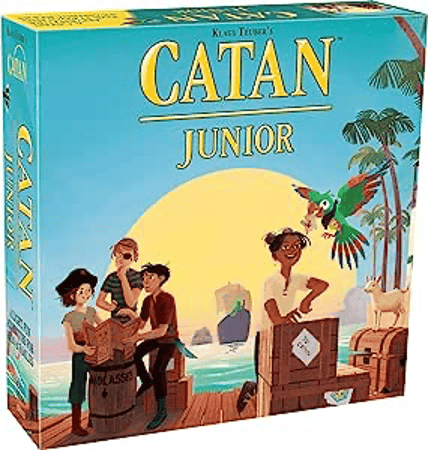
Catan Junior
By: Catan GmbH Players: 2-4 Time: 30 minutes
Become part of a fearless band of adventurers on a mission to discover and capture four sacred treasures from the ruins of a perilous paradise. Make sure to watch out for the dreaded Ghost Captain!
Catan Junior is a scaled-down version of the original ‘Settlers of Catan’, designed for younger players. Everyone plays as sea-faring adventurers, whose goal is to build seven pirate lairs. A pirate’s lairs and ships (which are also crucial in winning) need to be constructed from various resources, which can be gathered from the various islands that are dotted on the game board.
A die is rolled at the start of each turn to determine what resources are generated. A resource is associated with each island and as long as a player’s lair is adjacent to this island they receive that resource. All the while there is a Ghost Captain (who replaces the robber from the original game) and if a 6 is rolled on the die, the captain moves. He then prevents any adjacent players from receiving resources from the island he occupies.
Following the die roll, the active player can then choose to build something as long as they have enough resources. Building more lairs and ships will extend the player’s reach and allow them to gather more resources from die rolls each turn. If players lack the resources they need, they can trade one of their resources with the marketplace to bring them closer to building their ships and lairs next turn.
There are also ‘Coco’ the parrot tiles that players can buy each turn. These are initially face down and when purchased and flipped over will activate an effect. The results can vary greatly and range from moving the ghost to receiving a huge haul of resources. Players will need to plan ahead and be strategic in order to build their lairs first!
Catan Junior does a great job of making the original game more accessible for younger players but still adds enough of a challenge to get them thinking. The aesthetic of pirates is certainly more interesting and captivating than the original. Utilizing problem-solving and strategic thinking, players of all ages will find this strategy game plenty of fun!
Check out our Full review of Catan Junior here.
We earn a commission if you make a
purchase, at no additional cost to you.
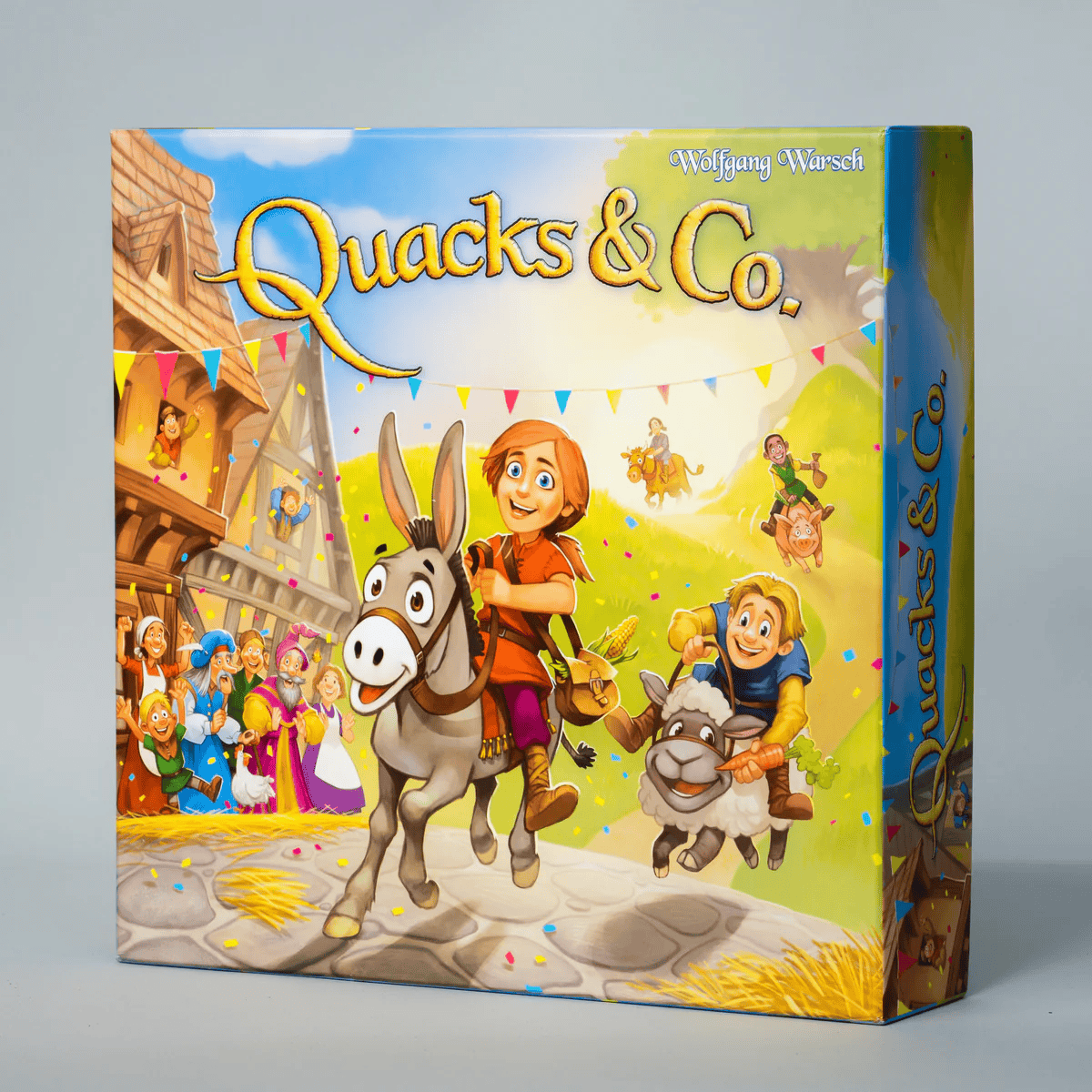
Quacks and Co.
By: Schmidt Spiele Players: 2-4 Time: 45 minutes
In the bustling market of Quedlinburg, players take on the roles of potion makers, trying their luck at brewing the most potent concoctions. Welcome to “Quacks and Co.,” a game where risk and reward collide in an exciting blend of strategy and chance.
“Quacks and Co.” is designed with younger players in mind but offers depth and excitement that will keep adults engaged too. Each player starts with a bag of ingredient chips, each with their own special properties. On their turn, players will draw chips from their bag and add them to their potion. However, drawing too many of one type of ingredient can cause the potion to explode, ending their turn prematurely. The key to success lies in knowing when to push your luck and when to stop.
Throughout the game, players can purchase additional ingredients to add to their bags, allowing for more potent potions and safer draws. The available ingredients change from game to game, providing a dynamic and replayable experience. The player who can best manage their ingredients, take calculated risks, and adapt to the changing market will emerge victorious.
“Quacks and Co.” is a thrilling introduction to push-your-luck and bag-building mechanics for kids, while the variable setup and strategic depth ensure that it remains a favorite for game nights for years to come. The box also comes with multiple levels of complexity built into the box so it’s a game that can grow with your kids and introduce them to more complex mechanics over time.
Its vibrant artwork and whimsical theme of potion brewing make it an instant hit for the whole family and provides an immersive and interactive gaming experience.
We earn a commission if you make a
purchase, at no additional cost to you.
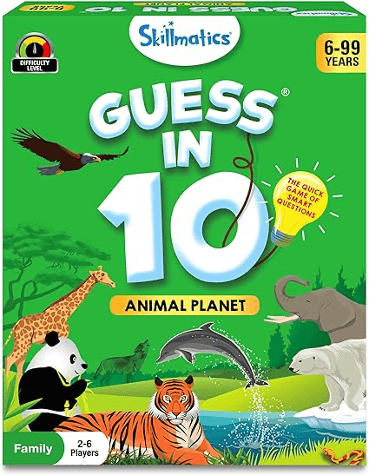
Guess in 10 Animal Planet
By: Skillmatics Players: 2-6 Time: 20 minutes
Is it a carnivore? Is it domestic? Does it live in groups? Think carefully and use deductive reasoning to ask the most intelligent questions you can. Be the first to collect seven game cards to win!
Guess in 10 is an educational game where players ask up to 10 questions to try and figure out which animal their opposing team has chosen. The game can be played head-to-head but it’s recommended to break into teams if there are more than three players. Each team will take three clue cards (to be used later) and the first player chooses the first card from the stack of animal cards, keeping it hidden from the other team at all times.
The first two buzzwords near the top of the card are read out and the guessing team can ask any question they like, as long as it can be answered with ‘yes’ or ‘no’. If the team are stumped, they can use their clue to pick up cards and the opposing team must read out facts listed on the card to help the other players with their guess.
The clue cards must be discarded when used, so playing them tactically is important. Two guesses can be made to identify the animal but if both are incorrect the card is discarded. If the animal is guessed correctly, the card is won.
There is a ‘double or nothing’ option once a card is guessed correctly: players can choose to answer the bonus question at the bottom of the card if they wish. Answering it correctly will mean they win the card and all three buzzwords on the next card must be revealed. Answering incorrectly means they lose their card!
Guess in 10 is an excellent game to keep kids entertained and teach them something at the same time. There are plenty of variations to the game, but Animal Planet is one of the most popular among kids. At home or on the go, it’s a great game with lots of learning opportunities and helps enhance children’s reasoning and problem-solving skills.
We earn a commission if you make a
purchase, at no additional cost to you.
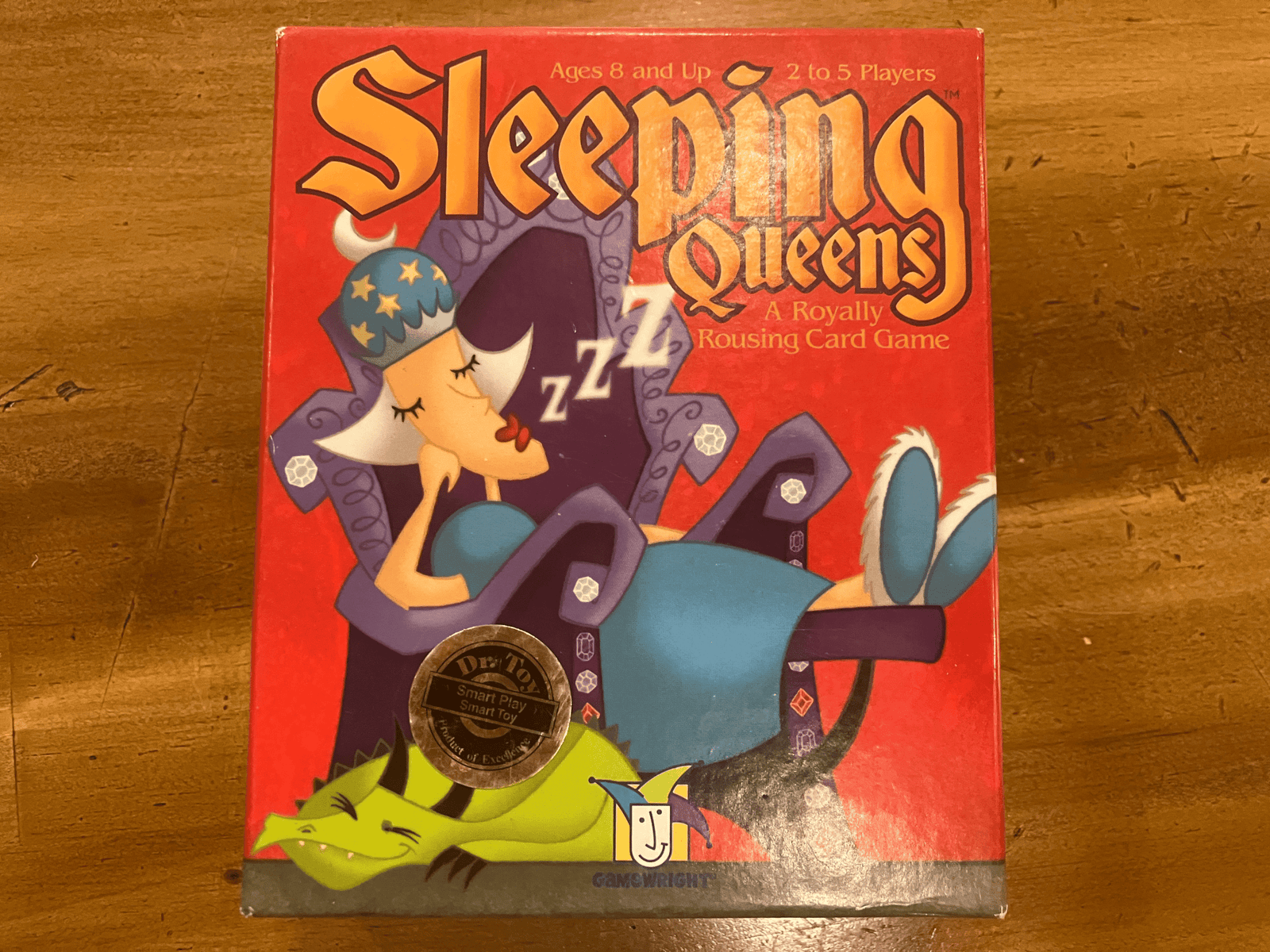
Sleeping Queens
By: Gamewright Players: 2-5 Time: 20 minutes
In the enchanting world of Sleeping Queens, players are whisked away to a kingdom where queens have fallen under a sleeping spell, and it’s their job to wake them up. This whimsical card game is designed for ages 8 and up, offering a delightful blend of strategy and chance that engages both children and adults.
The game consists of a deck of cards featuring a variety of queens, along with kings, knights, dragons, sleeping potions, and magical wands. The goal is simple: players must awaken a certain number of queens from their slumber to win. However, achieving this goal is not straightforward. Players can play king cards to wake a queen, but other players might play a sleeping potion to put someone else’s queen back to sleep, a knight to steal a queen, or a dragon to stop a knight. Using a wand can counteract a sleeping potion, adding another layer of strategy to the game.
Strategic thinking comes into play as players decide which cards to use and when, while memory aspects and math are introduced as players try to remember which queens have already been awakened. Sleeping Queens is not only fun and engaging, but it also helps develop math and logic skills through simple addition and subtraction as players tally their points.
With its imaginative theme, easy-to-learn rules, and quick gameplay, Sleeping Queens is one of the best board games for family game nights, encouraging social interaction, strategic thinking, and basic arithmetic skills. Its charming artwork and compelling gameplay make it a favorite among children, while adults will appreciate the strategic elements it offers.
We earn a commission if you make a
purchase, at no additional cost to you.
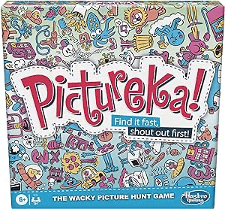
Pictureka
By: Hasbro Players: 2-7 Time: 20 minutes
A combination of ‘I-Spy’ and ‘Where’s Wally?’ with zany artwork, be the fastest and first to find all kinds of crazy creatures across the wonderfully illustrated game tiles.
Pictureka is fast to learn, set-up, and play through, but can lead to hours of fun! The game comes with 9 game tiles, each decorated on both sides with all manner of strange, wacky and wonderful things to captivate kids. These are set-up in a 3X3 grid at the start of the game and the various mission cards are separated into 3 different decks, shuffled, and placed face down. To win the game, players will need to complete the tasks on these mission cards and claim six to be declared the winner.
At the start of each turn, the active player will roll the dice and draw a card from the color indicated on it: green, blue, or red. If the top of the card shows an arrow, before they reveal the card the player must follow the directions and swap one tile with another, flip it over or rotate it. Green cards are solo games and players must roll the die and find that many of the object on the card before the timer runs out. Blue cards are for everyone, the picture appears once and the first player to find it wins the card. Red cards are where players bet how many of the thing on the card they can find.
The person who bids highest attempts to do so and if they can find that many before the timer runs out they keep the card. Those are the basic rules but if players want a longer or shorter game, they can agree on collecting more or less than six cards to win and split into teams to help younger players.
A fast and furious game, Pictureka is based on reaction time and memory. With tiles being reversed and flipped throughout the game, players will also have to be adaptable and think on the fly if they’re to win cards. A great party game for all ages, it’s easy to learn how to play but not always easy to find the picture in time!
We earn a commission if you make a
purchase, at no additional cost to you.
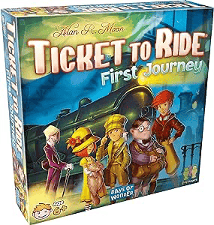
Ticket to Ride: First Journey
By: Days of Wonder Players: 2-4 Time: 30 minutes
A fast-paced journey across America for young engineers. Travel epic routes all across the country and be the first to punch six journey tickets to be declared the winner.
First Journey is part of the Ticket to Ride series and is specifically aimed at younger players and families in order to introduce them to the games. It takes place on a smaller game map, representing the United States, and cuts down the play time significantly to make the game more manageable for parents with children as young as six.
The object of the game is to complete train tickets by laying down trains across the routes listed on them. These can be very short or very long and stretch the length of the board.
On a turn players can do one of two things: take a train card or claim a route. Players can draw two train cards if they opt for option one. These cards will be one of six different colors and will allow players to claim train routes. Routes are claimed by laying the same number and the same colored train cards down as the route on the board.
If the route is 2 yellow spaces, the player can lay down two yellow train cards. They can then claim that route by laying their miniature trains on the board. Once all routes on the ticket have been claimed the player wins that ticket. The first to six is the winner and receives the golden ticket as a reward.
Easy to learn and quick to play, Ticket to Ride: First Journey’s simplified rules make for a great introduction to the series for younger players. With colorful components and a well-illustrated board, this game will keep kids imaginations captivated and coming back for more!
Check out our full review of Ticket to Ride First Journey here.
We earn a commission if you make a
purchase, at no additional cost to you.
Conclusion: Treat Your Kid to a Fast-Paced Game Night!
Board games are a fantastic way to spend quality time with your family. From teaching strategic thinking and arithmetic skills to encouraging social interaction and creativity, these three games are perfect for a fun and engaging game night with your children. So why not treat them to one of our picks for the best board games for 6 year olds and see their faces light up with excitement? With colorful components, imaginative themes, and easy-to-learn rules, these games are sure to become family favorites in no time. Happy gaming!
